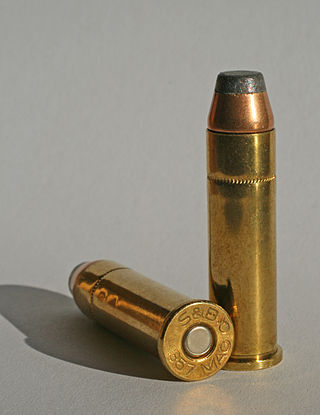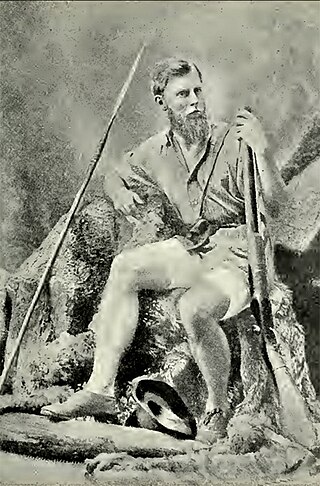Handloading, or reloading, is the practice of making firearm cartridges by assembling the individual components, rather than purchasing mass-assembled, factory-loaded ammunition.

A cartridge or a round is a type of pre-assembled firearm ammunition packaging a projectile, a propellant substance and an ignition device (primer) within a metallic, paper, or plastic case that is precisely made to fit within the barrel chamber of a breechloading gun, for the practical purpose of convenient transportation and handling during shooting. Although in popular usage the term "bullet" is often informally used to refer to a complete cartridge, it is correctly used only to refer to the projectile.
A muzzleloader is any firearm into which the projectile and the propellant charge is loaded from the muzzle of the gun. This is distinct from the modern designs of breech-loading firearms. The term "muzzleloader" applies to both rifled and smoothbore type muzzleloaders, and may also refer to the marksman who specializes in the shooting of such firearms. The firing methods, paraphernalia and mechanism further divide both categories as do caliber.

Flintlock is a general term for any firearm that uses a flint-striking ignition mechanism, the first of which appeared in Western Europe in the early 16th century. The term may also apply to a particular form of the mechanism itself, also known as the true flintlock, that was introduced in the early 17th century, and gradually replaced earlier firearm-ignition technologies, such as the matchlock, the wheellock, and the earlier flintlock mechanisms such as snaplock and snaphaunce.

A centerfire cartridge is a firearm metallic cartridge whose primer is located at the center of the base of its casing. Unlike rimfire cartridges, the centerfire primer is typically a separate component seated into a recessed cavity in the case head and is replaceable by reloading.
Internal ballistics, a subfield of ballistics, is the study of the propulsion of a projectile.

A blank is a firearm cartridge that, when fired, does not shoot a projectile like a bullet or pellet, but generates a muzzle flash and an explosive sound like a normal gunshot would. Firearms may need to be modified to allow a blank to cycle the action, and the shooter experiences less recoil with a blank than with a live round. Blanks are often used in prop guns for shooting simulations that have no need for ballistic results, but still demand light and sound effects, such as in historical reenactments, special effects for theatre, movie and television productions, combat training, for signaling, and cowboy mounted shooting. Specialised blank cartridges are also used for their propellant force in fields as varied as construction, shooting sports, and fishing and general recreation.

The .44 Smith & Wesson Special, also commonly known as .44 S&W Special, .44 Special, .44 Spl, .44 Spc, or 10.9×29mmR, is a smokeless powder center fire metallic revolver cartridge developed by Smith & Wesson in 1907 as the standard chambering for their New Century revolver, introduced in 1908.

The .32-20 Winchester, also known as .32 WCF , was the first small-game lever-action cartridge that Winchester produced. It was initially introduced as a black-powder cartridge in 1882 for small-game, varmint hunting, and deer. Colt produced a single-action revolver chambered for this cartridge a few years later.

The Dreyse needle-gun was a ground-breaking 19th-century military breechloading rifle. The gun, which was the first breech-loading rifle to use a bolt action to open and close the chamber, was the main infantry weapon of the Prussians in the Wars of German Unification. It was invented in 1836 by the German gunsmith Johann Nikolaus von Dreyse (1787–1867) who had been conducting numerous design experiments since 1824.

Overpressure ammunition, commonly designated as +P or +P+, is small arms ammunition that has been loaded to produce a higher internal pressure when fired than is standard for ammunition of its caliber, but less than the pressures generated by a proof round. This is done typically to produce rounds with a higher muzzle velocity and stopping power, such as ammunition used for defensive or hunting purposes. Because of this, +P ammunition is typically found in handgun calibers which might be used for defensive purposes.

An antique firearm is a term to describe a firearm that was designed and manufactured prior to the beginning of the 20th century. Although the exact definition of what constitutes an "antique firearm" varies between countries, the advent of smokeless powder or the start of the Boer War are often used as cut-off dates. Antique firearms are usually collected because of their historical interest and/or their monetary value.

A handgun is a firearm designed to be usable with only one hand. It is distinguished from a long gun which needs to be held by both hands and braced against the shoulder. The two most common types of handguns are revolvers and semi-automatic pistols, although other types such as derringers and machine pistols also see infrequent usage.
The .45-90 Sharps cartridge is a black powder round introduced in 1877 by the Sharps Rifle Manufacturing Company. Also known as the .45 2 4/10, the cartridge was developed for hunting and long range target shooting. In the modern day, it is used for Black Powder Cartridge Rifle competitions.
The following are terms related to firearms and ammunition topics.

A paper cartridge is one of various types of small arms ammunition used before the advent of the metallic cartridge. These cartridges consisted of a paper cylinder or cone containing the bullet, gunpowder, and in some cases, a primer or a lubricating and anti-fouling agent. Combustible cartridges are paper cartridges that use paper treated with oxidizers to allow them to burn completely upon ignition.

Four bore or 4 bore is an obsolete black powder caliber of the 19th century, used for the hunting of large and potentially dangerous game animals. The specifications place this caliber between the larger two bore and the lesser six bore. This caliber was the quintessential elephant gun caliber of the black powder safari rifles. The caliber was also used for the Coffman cartridges used for starting large aero engines such as the Rolls-Royce Griffon as used in the later Marks of Supermarine Spitfire.

The .500 Nitro Express is a rifle cartridge designed for hunting large and dangerous game animals in Africa and India. This cartridge was primarily designed for use in double rifles though various single shots were produced on the Farquarson action and at least one major company (Heym) produced it in bolt-action configuration. It was commonly available in two lengths: a 3.00 in (76 mm) and a 3.25 in (83 mm) version.
5-in-1 blanks are blank cartridges that can be used in a variety of firearms. They are specifically made for theatrical use and are commonly used in real firearms for dramatic effect. Since the loud report and flash of ignition, and not the projection of a bullet, is the goal of the cartridge, it can be used in firearms with different bore sizes. These cartridges can be loaded with different charges, ranging from quarter-load charges for indoor scenes and scenes around animals, up to full-load charges for outdoor firing.
In firearms and artillery, the primer is the chemical and/or device responsible for initiating the propellant combustion that will push the projectiles out of the gun barrel.












